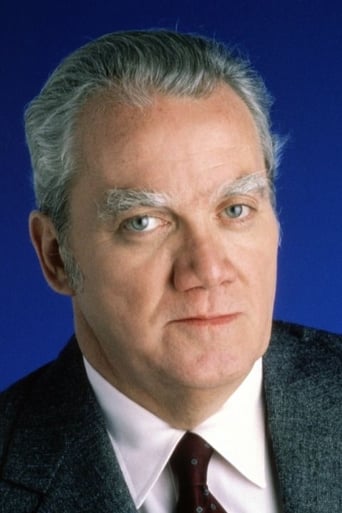TrueJoshNight
Truly Dreadful Film
Marketic
It's no definitive masterpiece but it's damn close.
Freaktana
A Major Disappointment
Geraldine
The story, direction, characters, and writing/dialogue is akin to taking a tranquilizer shot to the neck, but everything else was so well done.
James Hitchcock
Ken Harrison, a young sculptor in his early thirties, is seriously injured in a road accident. End of story."End of story", that is, in the sense of "end of any physical action". Not in the sense of "end of the film". Ken's life is saved, but he is paralysed from the neck down. When he discovers that he is unlikely ever to regain the use of his limbs he decides that he wants to die and asks the doctors to end the medical treatment which is keeping him alive. The rest of the film is essentially one long debate about the rights and wrongs of euthanasia and the right to die.Ken's main antagonist in this debate is his doctor, Michael Emerson. Although the case against euthanasia is often presented in religious terms, here it is presented in purely secular ones. If Dr Emerson has any deep religious convictions, these are never expressed in the film. He believes passionately, however, that death is an enemy against which it is his duty as a doctor to fight; to allow a patient effectively to take his own life would represent a surrender to that enemy and a dereliction of that duty. Ken therefore finds himself in a "Catch-22" situation. He must be able to show that he is sane and rational enough to make the decision to end his life. Emerson, however, considers that a wish to die is in itself evidence of insanity and irrationality. Ken's dilemma can only be solved by hiring a lawyer to sue the hospital.Richard Dreyfuss as Ken and John Cassavetes as Dr Emerson put across their respective points of view skilfully and with sincerity, but this cannot hide the fact that "Whose Life is it Anyway?" simply does not work as a film. At one time filmed versions of stage plays were done in a similar way to theatrical productions but by the seventies and eighties this was often seen as unsatisfactory because of the differences between the two media. When plays were filmed, therefore, the general tendency was to "open them up" by filming on location as well as on studio sets, by taking liberties with the playwright's text, often making significant changes to the plot and even introducing extra characters.I have never seen Brian Clarke's play, but I suspect that this is a story that would work better in the theatre than in the cinema. There is very little physical action; most of the action consists of lengthy discussions around a hospital bed in which the main character lies paralysed. Such a plot does not lend itself to the "opening up" device at all, and the resulting film is very static, dominated by talk at the expense of action. Although it is well written and there is some good acting, I am surprised that a film was ever made of such an uncinematic subject. 4/10
tributarystu
Sane people can have the desire to die, it's an indisputable fact. In arguing why, "Whose Life Is It Anyway?" tries to balance a dispute so personal, that it seems bound to fail. And yet, it does not! The story features a sculptor who is left paralyzed after a wrecking car accident and ends up in a most undesirable situation. His status renders him incapable of being the person he once was and found in the impossibility to reconcile his former self with his current condition, Ken Harrison decides to die.His quest is, most obviously, a difficult one. The doctors do not support him in his decision and in this debate - doctor::patient - it is where the film conjures the most solid arguments in its plea. Going beyond the usual ethical components of this choice, the film manages to assert a very personal position to the main protagonist, which therefore makes the whole experience one of anguish on a very personal level. And this is where it makes its point: there is no universal justification for death and the world has no right to interfere in the sphere of anyone's consciousness. Perhaps it is at times overly dramatic and it treats the subject with tantalizing care, but in the end, I felt the film balanced all the facts concerned in a convincing and compelling way, vividly portraying the painful demise of a strong mind in face of the cruelty of destiny. It might seem to take a stance on every man's right to choose his fate, but in the matter at hand (whether death by will is right or wrong) it emits no absolute messages.Beyond everything, Richard Dreyfuss sustains an authentic feeling of intellectual pain, in his convincing performance. And it is only in pain and suffering that we can look into ourselves to understand how much we are willing to bear in this world and what makes us be. Suicide I do not believe a solution, but then again, I am on the other side of the river, where things seem filthy green, rather than nothing at all. We are so alone in death and pain, that nobody can truly claim to understand us.
indikaur
This is a great movie for future nurses, etc. also saw Gross Anatomy, Chicogo Hope, and other medical related programming .....THANX for the inspiration / look up John Cassavetes, too.....He was the Medical Director, in Who's Life is it, Anyway, indikaur@khalsa.com "e" me, later. I really enjoyed the fact that it was in real hospital and actress nurses, possibly real ones, too and the close ups of equipment, and that crazy orderly, going' after SN as well as mini tours of that hospital when he was on the way to other areas within hospital, if you could tell me which hospital is was, I'd be grateful and the name of the school of nursing, too .....
bama1111
A brilliant performance by Richard Dreyfuss...and wonderful performances by Christine Lahti and John Cassavetes and Bob Balaban and Kenneth McMillan. I've watched this movie a number of times since it came out and it never fails to move me. Since I don't, and never have, worked in a hospital I can only believe that some of the events are a bit far fetched [jamming in the basement and smoking dope, for example] but getting past them, you have a riveting story. A battle for a human life. He wants to be allowed to die and they are determined to keep him alive. There are many wonderful moments, especially the hearing, that express the notion that both/neither is right/wrong. But whatever side you take you can't be disappointed by this moving story and these moving performances. In my opinion, 10/10.







